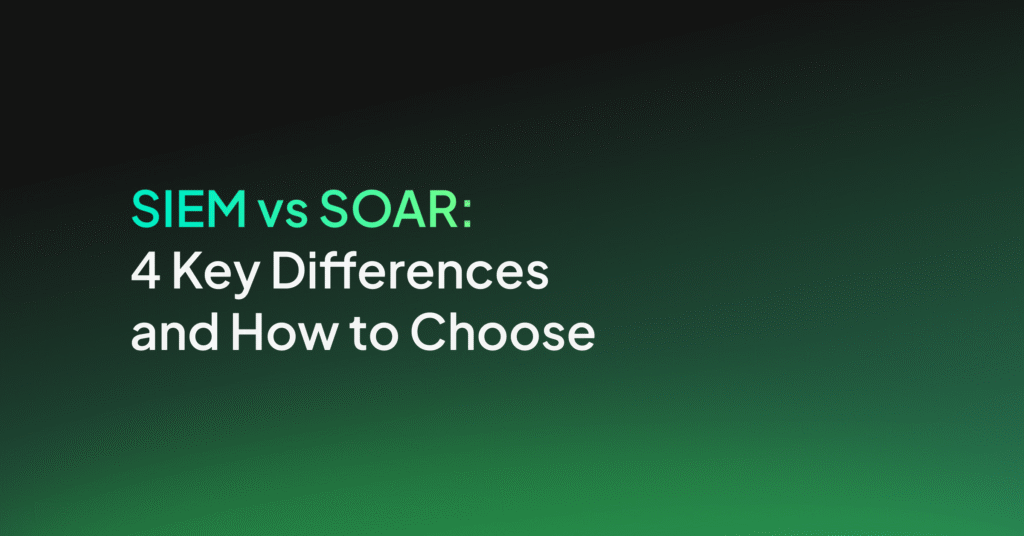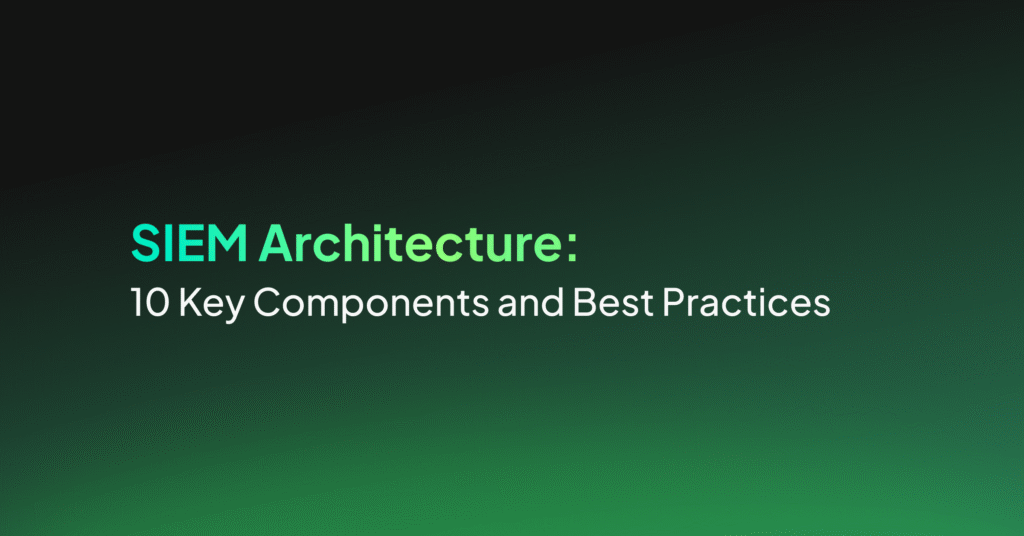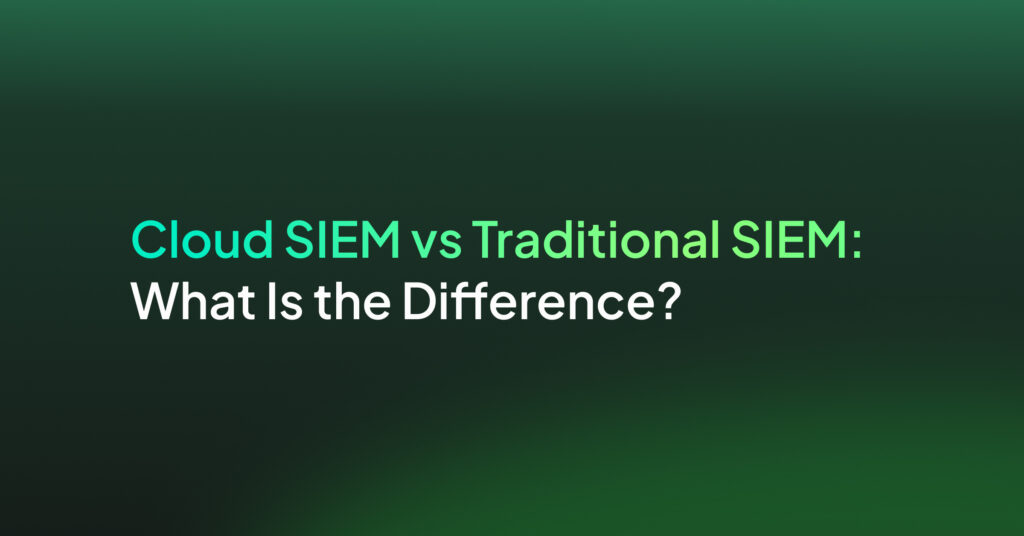What Is SIEM, How It Works, and Essential SIEM Tools to Consider

How Does SIEM Work?
SIEM can be broken down into four main components:
Log Management
Log management involves collecting and storing log data from various sources within an organization’s IT infrastructure. This data can include user activities, system events, and network traffic.
SIEM solutions not only collect this data but also normalize it, meaning they convert the data from different sources into a standard format. This process is crucial because it allows the data to be analyzed and compared accurately.
Learn more in our detailed guide to SIEM logging (coming soon)
Event Correlation and Analytics
Once the log data is collected and normalized, SIEM solutions use advanced analytics to correlate events and identify patterns. This process involves comparing new events with known threats, looking for anomalies, and analyzing the sequence of events to understand the context.
SIEM can correlate seemingly unrelated events and identify potential threats. For instance, a series of failed login attempts followed by a sudden spike in data transfer could indicate a potential security breach.
Incident Monitoring and Security Alerts
SIEM involves continuous monitoring for security events. Once a potential threat is identified, SIEM solutions generate alerts to notify the security team. These alerts can be customized based on the severity of the threat, ensuring that critical issues are prioritized.
SIEM solutions also provide tools for incident management. This includes capabilities for tracking, managing, and documenting security incidents. It can also include integrations with other systems for automated response actions, such as blocking IP addresses or disabling user accounts.
Compliance Management and Reporting
Compliance is a significant concern for many organizations, especially those in regulated industries. SIEM solutions can help simplify compliance management by providing a central repository for all security-related data.
SIEM tools can generate detailed reports to demonstrate compliance with various regulations. These reports can include information on how data is collected, stored, and protected, as well as how security incidents are handled. This can save organizations significant time and resources during audits.
Benefits of SIEM
Implementing a SIEM solution can offer organizations several benefits:
Improving Visibility
SIEM solutions enhance the visibility into an organization’s IT environment. By centralizing the collection and analysis of data from multiple sources, SIEM tools provide a comprehensive view of the security status of an organization’s IT infrastructure. This visibility is critical for detecting hidden threats that might otherwise go unnoticed in a more fragmented security setup. Enhanced visibility also means that organizations can better comply with industry regulations and standards, as they have a clearer understanding of their security posture.
Improving Alert Quality
SIEM systems improve the quality of security alerts. By aggregating data from various sources and using advanced analytics, SIEM tools can filter out false positives, thereby reducing alert fatigue among security teams. This refined alerting process means that the alerts which are raised are more likely to signify genuine threats, allowing security teams to focus their efforts more effectively and reduce the time to respond to real security incidents.
Enabling Rapid Response
With the ability to analyze and correlate data in real time, SIEM enables organizations to detect and respond to threats rapidly. This speed is crucial in mitigating the impact of security breaches. When a SIEM system identifies a potential threat, it can trigger automated security responses or alert the appropriate personnel to take immediate action. This rapid response capability is vital in a landscape where the speed and sophistication of cyber attacks are constantly increasing.
What Is the Difference Between SIEM and SOC?
SIEM is a software solution that collects and analyzes data from various sources within an organization’s IT infrastructure. It provides real-time analysis of security alerts generated by applications and network hardware. SIEM is the brain that processes security-related data, identifies potential threats, and creates alerts for suspicious activities.
A security operations center (SOC) is a centralized unit that houses an organization’s cybersecurity team. It is the nervous system where all the cybersecurity activities are controlled and managed. The SOC team uses tools like SIEM to monitor, detect, investigate, and respond to cybersecurity incidents. Therefore, while SIEM is a tool, SOC is the team that uses the tool.
Learn more in our detailed guide to SIEM and SOC.
SIEM Use Cases
There are several important use cases for SIEM, which allow SOC teams to manage their organization’s security.
Security Monitoring
With the increasing complexity of cyber threats, it’s no longer sufficient to have a static defense in place. You need to be actively monitoring your network for any signs of intrusion or unusual activity. SIEM solutions enable this by collecting and analyzing logs from across your IT environment.
For example, if an employee’s user account starts making numerous failed login attempts, the SIEM system would pick up on this abnormal behavior and alert the security team. The SIEM can correlate the failed login attempts with suspicious network traffic or malware detected by antivirus solutions. With this information, the security team can take immediate action to mitigate the threat.
Learn more in our detailed guide to SIEM security (coming soon)
Advanced Threat Detection
Advanced threat detection in SIEM involves identifying complex cybersecurity threats that are typically difficult to detect with traditional security measures. This includes detecting malware, ransomware, insider threats, and persistent attacks. SIEM systems use various techniques like behavioral analytics, anomaly detection, and artificial intelligence to identify unusual patterns that could indicate a sophisticated cyber attack.
For instance, SIEM can detect when a user accesses sensitive data at unusual times or from unusual locations, which could signify a compromised account. It can also identify patterns of network traffic that resemble known attack methods, such as data exfiltration or lateral movement within the network. By incorporating advanced threat detection capabilities, SIEM systems provide an additional layer of defense against complex and evolving cyber threats.
Forensics and Incident Response
When a security incident occurs, it’s vital to understand exactly what happened so you can prevent it from happening again. This is where the comprehensive logging and data aggregation capabilities of SIEM solutions are useful.
SIEM can provide a detailed timeline of events leading up to an incident, making it easier for investigators to piece together the puzzle. For example, if a ransomware attack occurs, the SIEM system could provide information on when the initial infection occurred, how it spread through the network, and what data was affected.
SIEM solutions can also assist with incident response. They can provide real-time alerts, enabling the security team to respond to an incident immediately. They can also automatically assemble the full context of the security incident, making it easier to investigate and respond to the threat.
How SIEM Integrates Advanced Security Technologies
Modern SIEM solutions include advanced security technologies, which can significantly enhance its capabilities. These include:
User and Entity Behavior Analytics (UEBA)
User and Entity Behavior Analytics (UEBA) is a cybersecurity process that uses machine learning, data science, and detailed analytics to identify when a user or machine is acting unusually. In the context of SIEM, UEBA significantly enhances its ability to detect advanced threats.
While SIEM solutions can provide alerts for predefined patterns, UEBA brings in a layer of intelligence that can identify threats that do not match any known patterns. This makes SIEM solutions equipped with UEBA capabilities significantly more effective in detecting sophisticated threats.
Security Orchestration, Automation, and Response (SOAR)
Security Orchestration, Automation, and Response (SOAR) is a technology that enables automated response to security incidents. While SIEM provides the intelligence, SOAR provides the action.
Integrating SIEM with SOAR allows organizations to respond to security incidents more swiftly. The SIEM solution identifies the threat, and the SOAR solution automates the response. This not only speeds up the incident response process but also frees up the SOC team to focus on more complex tasks.
Extended Detection and Response (XDR)
Extended Detection and Response (XDR) is a security approach that integrates multiple security technologies into a single solution. While SIEM provides a centralized location for collecting and analyzing data, XDR takes it a step further by providing automated response capabilities.
Though XDR seems similar to SOAR, it differs in its scope. While SOAR focuses on the detection and response, XDR provides a more comprehensive security solution that includes prevention, detection, response, and prediction.
Related content: Read our guide to managed detection and response
Top SIEM Tools
Coralogix
With in-stream data analysis, Coralogix’s SIEM offers the most cost-effective observability for security data. With over 300 integrations and quick start extensions with out-of-the-box alerts, dashboards and log parsing, all your security data can be ready for analysis in no time at all.
Coupled with 24/7 managed security services from our seasoned research team, you can sleep better with Coralogix.
Splunk
Splunk is widely recognized for its powerful data analytics capabilities. It functions by collecting and indexing data from various sources, including logs, network traffic, and cloud sources.
Splunk offers robust search, analysis, and visualization capabilities. It allows security teams to quickly sift through vast amounts of data to identify patterns and anomalies that could indicate security incidents. Splunk’s flexible architecture supports a wide range of applications beyond security, including operational intelligence and business analytics.
IBM QRadar
IBM QRadar is known for its advanced analytics and its ability to correlate data from various sources to identify potential threats. It’s a platform that includes log management, network traffic analysis, and user behavior analytics.
One of QRadar’s key features is its cognitive intelligence, which uses machine learning to help identify threats more accurately and reduce false positives. This capability enhances its effectiveness in detecting sophisticated attacks. QRadar also offers extensive integration options, allowing it to work seamlessly with a wide range of network devices and applications.
LogRhythm
LogRhythm uses an integrated approach to SIEM, combining advanced analytics, log management, network monitoring, and endpoint detection. It focuses on workflow and collaboration, providing tools that help security teams manage and respond to incidents more efficiently.
LogRhythm also features a machine learning component, aiding in the detection of anomalous behavior and advanced threats. Its user interface is designed to enable easy navigation and interpretation of data for security analysts.
ArcSight
ArcSight, developed by Micro Focus, focuses on threat detection and response. It is designed to handle large volumes of data and is well-suited for large enterprises with complex security needs.
ArcSight’s correlation engine is particularly useful for identifying and prioritizing security events, helping analysts focus on the most critical threats. It also supports compliance reporting features, making it easier for organizations to adhere to regulatory requirements.
SIEM Implementation Best Practices
SIEM is only as effective as the team that uses it, so it’s important to understand the best practices for working with SIEM.
Fine-Tune Correlation Rules
Correlation rules help security teams identify potential threats by analyzing patterns and sequences of events. However, out-of-the-box correlation rules may not be efficient for your specific environment. Therefore, you need to fine-tune them to adapt to your environment.
Fine-tuning correlation rules require a good understanding of your business and security requirements. You should ensure that your rules are set to detect the most relevant threats to your organization. Also, they should be updated regularly to keep up with evolving threats.
Too many false positives can be as detrimental as missing a real threat. Therefore, it’s essential to strike a balance between being overly cautious and ignoring potential risks. This can be achieved by adjusting the sensitivity of your correlation rules.
Monitor Access to Critical Resources
Monitoring allows you to keep track of who is accessing what resources and when. It also helps to identify any unauthorized access attempts, providing a chance to stop potential data breaches before they occur.
Monitoring access to critical resources can be done in a variety of ways. One common method is to use log data from various sources such as firewalls, VPNs, and access control systems. This data can then be analyzed to identify patterns that may indicate unauthorized access or misuse of resources.
However, it’s not enough just to collect and analyze log data. You also need to have a process in place for responding to any anomalies detected. This might involve investigating the incident, blocking the user’s access, and notifying law enforcement if necessary.
Learn more in our detailed guide to SIEM monitoring (coming soon)
Defend Network Boundaries
Defending your network boundaries involves setting up firewalls, intrusion detection systems (IDS), and intrusion prevention systems (IPS) to secure your network from external threats. You need to monitor these regularly to ensure they are working effectively. Remember that modern network boundaries extend to cloud environments, Wi-Fi networks and mobile devices, which your SIEM system should be able to monitor.
Test Your SIEM
Testing your SIEM system involves simulating various security events to ensure that your SIEM system can detect and respond to them effectively. Testing should be done regularly to keep up with changes in your environment and evolving threats. It should involve all aspects of your SIEM system, including data collection, correlation rules, alerting, and incident response.
While testing your SIEM, it’s also important to review and update your incident response plan. This will ensure that your team knows what to do in the event of a security incident and can respond effectively.
Implement Response Plan
Having a plan in place ensures that your organization can respond quickly and effectively to any security incidents. The plan should outline the roles and responsibilities of each team member, the steps to be taken in the event of an incident, and the communication channels to be used.
Implementing a response plan involves training your team on how to respond to various types of incidents. This can involve conducting drills or simulations to test their readiness. The goal is not just to detect and respond to incidents, but also to recover from them and prevent future occurrences.
Cloud Native Security with Coralogix
Coralogix’s security offering includes robust and cost-effective SIEM together with MxDR (managed extended detection and response) from our experienced security team.
Schedule a demo with our team to learn more about our SIEM and all our observability offerings.
See Additional Guides on Key Compliance Management Topics
Together with our content partners, we have authored in-depth guides on several other topics that can also be useful as you explore the world of compliance management.
Hipaa Compliant Hosting
Authored by Atlantic
- HIPAA-Compliant Hosting
- How to Make a HIPAA Compliant Website: Checklist and Guide
- HIPAA Compliant Patient Client Portal – HIPAA Cloud Server Setup
Digital Commerce
Authored by Cloudinary




